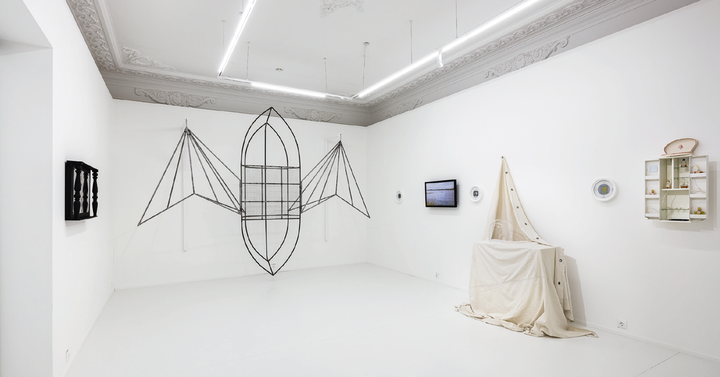Moscow. The post-Soviet art scene might be defined by the state of “fatherlessness.” Most of the “founding fathers” of non-conformism and conceptualism emigrated to Western Europe or North America, while the younger generation of artists were left on their own, with almost no authority to follow and rely on. In this light, Yan Ginzburg’s artistic method might be viewed as a consistent reinvention of local art history and a restoration of the continuity of tradition by means of what I would call “Oedipalization.” In his oeuvre, he has frequently paid homage to “dead white heterosexual males” (for example in his work The Room of Geniuses, presented last year at the Garage Museum) or even used existing figures as ready-made material. For several years, he worked with the legacy, biography, and personal belongings of the almost forgotten artist and his friend Joseph Ginzburg and after his death even borrowed his surname.
Closed Fish Exhibition. Reconstruction, mounted by Yan Ginzburg together with Dmitry Khvorostov and their students from the Baza institute, is a tribute to another chapter of Russian art history that is not well-known abroad, namely the works of Elena Elagina and Igor Makarevich, representatives of the middle generation of Moscow conceptualism. While sharing with other conceptualists an obsession with language and its complex relationship to images, they are also interested in nature, science, and technology, which they explore through mystifications. In their project Closed Fish Exhibition (1990), they recreated works from the eponymous exhibition of realist drawings that took place in 1935 in Astrakhan to promote the local fish industry. Following the catalogue, which contained only participants’ names and titles, Ginzburg and Khvorostov have now imagined what the works could have looked like by literally visualizing Stalin-era bureaucratic clichés. The resulting assemblages were presented at a country house that was used as an underground museum (MANI).
To a certain extent, Ginzburg’s and Khvorostov’s project falls under the category of reenactment exhibitions that have recently risen to prominence worldwide: most famously When Attitudes Become Form: Bern 1969/Venice 2013 or, closer geographically, the two-part project Reconstructions that reproduced the key Moscow exhibitions of the 1990s at the Ekaterina Foundation (2013 and 2014). However, in this case the term “reconstruction” is conceptualized and called into question. It is first of all an artistic interpretation of a historical fact and, second, it is already a reconstruction of a reconstruction. More precisely, the research group of students and their mentors investigated and found traces of the original show that were not known to Elagina & Makarevich and hence revised their “blind” interpretation. As a result, we see a recursive project that not only invents history but also rewrites the previous inventions.
The very neat exhibition design provides several buoy-rings — round canvases hung on the walls that decipher the complex narrative of the first two halls. Each of them contains the title of an original piece from the 1930s, a reproduction of an Elagina & Makarevich piece (in the center), and the name of a cover made by a different Baza student. The first room embraces the aesthetics of forensics, featuring works involving research around the Astrakhan district. Some of the artists worked with archival portraits of the original show’s participants, while others explored the current economic state of the region’s industries. The artworks selected for the second room shatter this aura of scientific investigation and push the viewer onto more speculative and imaginative terrain. The highlight is definitely Maxim Novikov’s Slashes. Ink. This huge symmetrical metal construction materializes an invention by an engineer from Astrakhan that was supposed to facilitate fish loading. Suspended in an immaculate white cube, it looks like something between Vladimir Tatlin’s Letatlin, Chris Burden’s Late Gothic structures, and a fossilized skeleton from a natural history museum.
The final section develops this absurdist tone further and features kitschy, bizarre, and surrealist constructions made of industrial objects, wooden elements, bones, and letters. What seem to be original Elagina & Makarevich assemblages turn out to be Ginzburg’s own works skillfully imitating their style. There are only two exceptions – a new commission by the conceptualist duo (Fishing Tackle) and an original drawing from the 1935 exhibition. The younger artist thus operates similarly to a professional forger who uses ancient pigments to cheat mass spectrometry: in this case he relies on time-worn Soviet design products and even incorporates old-fashioned typefaces. The resulting effect is not only a schizophrenic collapse of temporalities but also a suspension of originality, authorship, and authenticity.
Today, under the conditions of a pandemic in which the young are physically isolated from the elderly, such cross-generational dialogue is a good example of well-timed care and attention. It shows that art does not exist in a vacuum or emerge ex nihilo, but only comes about through awareness of one’s own history, predecessors, and peers. However, the imposed continuity of tradition and recourse to the “father figures” may lead to a trap. “Homagism” – the term the curators use to define their tactic – can easily be suspected of narcissistic self-historization and even self-aggrandizement. At the same time, the intertextual and highly sophisticated concatenations of references, which are almost impossible to unravel without prior knowledge, make this exhibition even more “closed” than the original fish exhibition.


